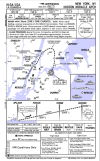[This is a repost of what I said on my private airline forum.]
It upsets me that this is often called, The Miracle on the Hudson. While it was a challenging situation and a fortunate outcome, it was hardly a “miracle.” Most everyone I flew with could have probably done as well. Ditching in a wide and long, wet landing strip, even if it is water and without thrust is certainly doable for most of us. And if you seek miracles, I vote for Al Haynes in Sioux City and his partners.
While we all are aware of the TOGO issue, some other things make this less than perfect. To wit from the NTSB report:
16. “The captain’s difficulty maintaining his intended airspeed during the final approach resulted in high angles-of-attack, which contributed to the difficulties in flaring the airplane, the high descent rate at touchdown, and the fuselage damage.”
"The investigation determined that the airplane’s descent rate at the time it impacted the water was 12.5 fps, more than three times the descent rate of 3.5 fps assumed during ditching certification… which significantly exceeded the values established to demonstrate compliance with the certification criteria. These external pressures were sufficient to cause the large-scale collapse and failure of the aft fuselage frames, cargo floor, and passenger floor struts and to initiate cracking of the lower fuselage skin, allowing water to enter the airplane. Further, the water ingress and continued forward motion of the airplane through the water resulted in post impact pressures and suction forces that caused additional damage, including the failure of the lower fuselage skin panel and aft pressure bulkhead. Therefore, the NTSB concludes that the airframe damage was caused by the high-energy impact at the aft fuselage and the ensuing forward motion of the airplane through the water."
This is from simulator recreations:
"During the first flight scenario, all of the pilots were able to achieve a successful landing in both simulators. The flight path angles at touchdown for these landings ranged from -0.8° to -1.3°. Regarding the second flight scenario, 20 runs were performed in the engineering simulator from a preprogrammed point shortly before the loss of engine thrust in which pilots attempted to return to either runway 13 or 22 at LGA or runway 19 at TEB. Five of the 20 runs were discarded because of poor data or simulator malfunctions. Of the 15 remaining runs, in 6, the pilot attempted to land on runway 22 at LGA; in 7, the pilot attempted to land on runway 13 at LGA; and in 2, the pilot attempted to land on runway 19 at TEB. In eight of the 15 runs (53 percent), the pilot successfully landed after making an immediate turn to an airport after the loss of engine thrust. Specifically, two of the six runs to land on runway 22 at LGA, five of the seven runs to land on runway 13 at LGA, and one of the two runs to land on runway 19 at TEB immediately after the loss of engine thrust were successful.88 One run was made to return to an airport (runway 13 at LGA) after a 35-second delay,89 and the landing was not successful.
"Regarding the third flight scenario, a total of 14 runs were performed in the engineering simulator in which pilots attempted to touch down on the water within a target flightpath angle of -0.5°, consistent with the structural ditching certification criteria. Two of the 14 runs were discarded because of poor data. Of the remaining 12 runs, 4 were attempted using CONF 2, 4 were attempted using CONF 3, and 4 were attempted using CONF 3/Slats only."
"In 11 of the 12 runs, the touchdown flightpath angle ranged between -1.5° and -3.6° (the touchdown flightpath angle achieved on the accident flight was -3.4°). In 1 of these 12 runs, a -0.2° touchdown flightpath angle was achieved by an Airbus test pilot who used a technique that involved approaching the water at a high speed, leveling the airplane a few feet above the water with the help of the radar altimeter, and then bleeding off airspeed in ground effect until the airplane settled into the water."
The NTSB concludes that the captain’s difficulty maintaining his intended airspeed during the final approach resulted in high AOAs, which contributed to the difficulties in flaring the airplane, the high descent rate at touchdown, and the fuselage damage.
Miracle my ass. A caveman could have done as well, if not better.




